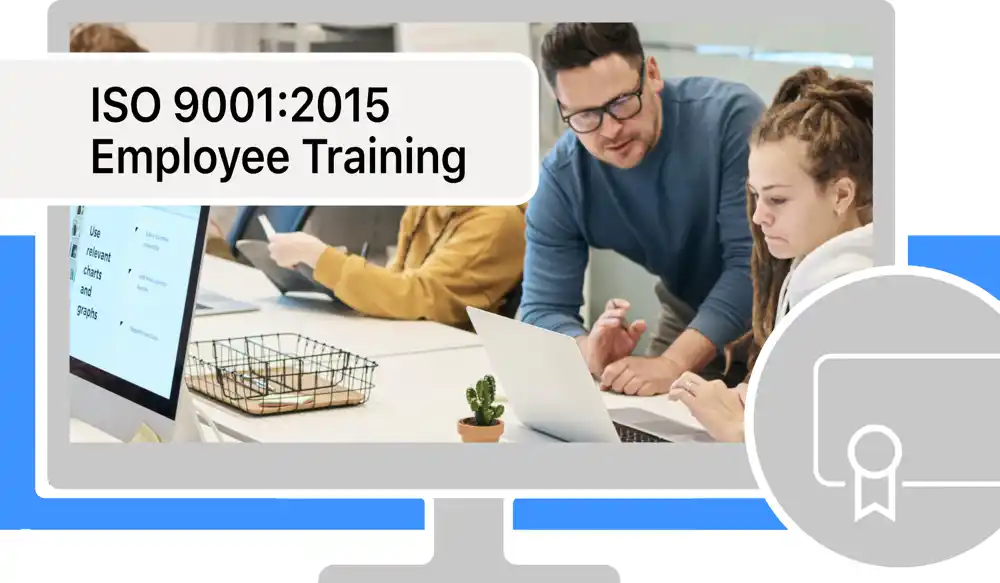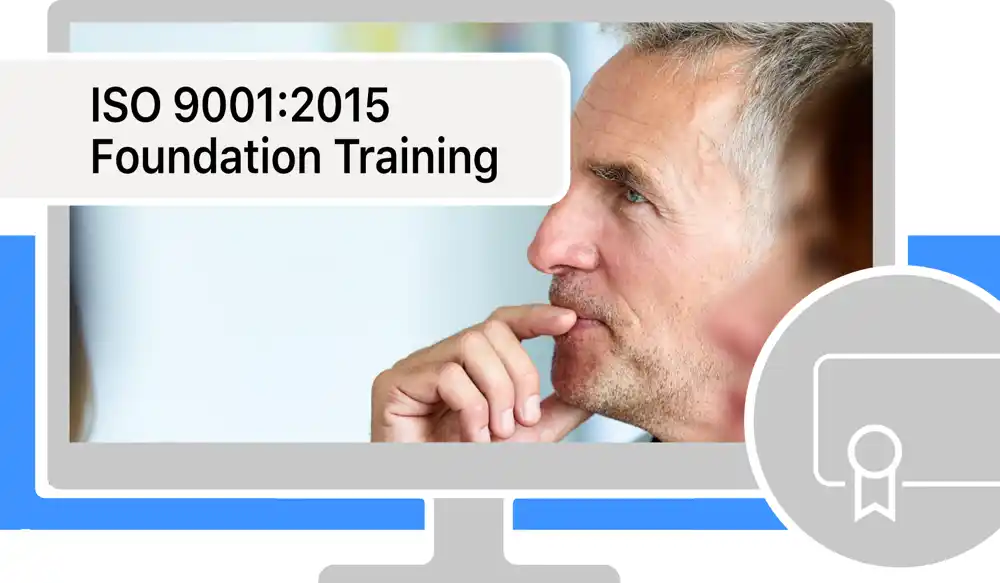What is ISO 9001?
2 April 2024
ISO 9001:2015 is the most well-known and widely adopted quality management standard in the world, which demands a deeper exploration to understand its meaning and significance. It provides organizations with a framework to improve their operations, enhance customer satisfaction, and achieve certification. In this article, we will explain what ISO 9001 is, its significance for your business, and the steps required to get certified.
1:32


ISO 9001 Basics
ISO 9001 originated in 1987 and is published by the International Organization for Standardization (ISO). It is currently in its fourth revision, known as ISO 9001:2015, and is used by over a million organizations in 190 countries across various sectors and industries.
Before seeking certification, an organization must implement ISO 9001 and establish a quality management system (QMS) that aligns with the standard's requirements. While the primary objective of ISO 9001 is to improve quality and customer satisfaction, it also leads to broader operational enhancements and efficiency gains. When applied effectively, ISO 9001 becomes a valuable tool for overall business improvement.
For many companies, ISO 9001 serves as a marketing tool that brings greater prestige, increased customer opportunities, and access to new markets. The certification's benefits are what these companies often emphasize. To realize these advantages, organizations must establish an ISO 9001 QMS, adhere to all requirements, undergo compliance audits, and apply for certification.
What Is an ISO 9001 Quality Management System?
ISO 9001 is more than just quality control or assurance; it necessitates the establishment of a comprehensive quality management system (QMS). A QMS is an integrated approach to running a company or organization, enhancing overall performance.
A QMS provides management at all levels with tools to fulfill their responsibilities effectively. Depending on the company's existing organization, these tools may already be in use or could be entirely new.
While some associate ISO 9001 with quality control inspections, it encompasses a broader view of quality. ISO 9001 defines quality as the extent to which customer requirements are met, which may include expectations that are not explicitly expressed by the customer.
The ISO 9001 QMS covers a wide range of management processes, from strategic planning to document control to the calibration of measurement devices. Importantly, the QMS is an integral part of an organization's business processes and operates in conjunction with regular business operations. Quality is embedded in every process and every department within an organization.
What Are the Benefits of ISO 9001?
The implementation of ISO 9001 brings a range of benefits to an organization beyond certification. Some of the key advantages include:
ISO 9001 Certification's Marketing Value
ISO 9001 certification serves as an outstanding marketing tool, representing the world's most renowned quality standard. The ISO certification mark communicates quality and reliability to both domestic and international customers. If your competitors have not yet achieved ISO 9001 certification, marketing your certification can lead to a significant competitive advantage. Moreover, if your competitors are already certified, it becomes imperative for you to catch up promptly.
Using ISO 9001:2015 helps ensure that customers get consistent, good quality products and services, which in turn brings many business benefits.
International Organization for Standardization
Fulfilling Customer Requirements with ISO 9001
For an increasing number of companies, ISO 9001 certification has become a necessity. While accreditation was previously primarily required for government contracts, defense, and pharmaceutical sectors, today, numerous ISO 9001 registered companies demand that their suppliers also be certified. We have witnessed instances where clients urgently required ISO 9001 certification to retain crucial customers. Our advice is to have ISO already in place, rather than struggling to implement it under the impatient eyes of a valued customer.
Internal Improvements through ISO 9001
Many people overlook the fact that ISO 9001 serves as the foundation for significant operational improvements, extending beyond being a valuable certification. In actuality, ISO 9001 was designed as a tool for companies to enhance their operations and bottom line; the benefits of certification and marketing followed later. Internal benefits encompass a broad spectrum, including reduced rework and scrap, increased productivity and efficiency, lower employee turnover, and heightened customer satisfaction. In essence, ISO 9001 harbors the potential for substantial benefits that can positively impact the bottom line.
Applicability of ISO 9001 to Your Organization
ISO 9001 is designed to apply to any type of organization, in any industry, in any country. Whether your organization is a manufacturing company, a legal firm, a school, or a government department, ISO 9001 is relevant. Furthermore, whether your organization is for-profit or nonprofit, or if it is a small entity or a large enterprise, ISO 9001 applies. Given that it is an international standard, ISO 9001 is universally applicable, where some countries publish ISO 9001:2015 under the name of their accreditation board, such as ANSI in the USA, without altering its content.
What Does It Take to Get Certified?
Achieving ISO 9001 certification requires both time and financial investment. The specifics vary based on the implementation strategy you opt for and your company's unique circumstances. Typically, ISO 9001 is put into practice using one or a blend of the following methods:
Engage a Consultant
Employing a comprehensive ISO 9001 certification service is the quickest but most costly alternative, often favored by larger enterprises or organizations lacking internal resources.
It is crucial to select an experienced consultant capable of devising customized, efficient solutions tailored to your business's specific needs. The consultant should instill motivation and ownership among management and staff for sustained success. Additionally, a seamless hand-over process is essential for your company to sustain ISO 9001 practices once the consultant departs.
Our ISO 9001 Certification Service meets these criteria, offering affordability, and ensuring certification in as little as 2-3 months.
Start from Scratch
This option suits companies whose top management has the time and interest to fully immerse themselves in the ISO 9001 framework. While an in-house developed system can garner significant support from staff when done correctly, the substantial time commitment and potential for errors often render this approach impractical. If you lean towards this route, acquiring the ISO 9001:2015 standard and comprehensively understanding its contents are imperative to success.
Utilize a Certification Kit
A certification kit empowers a staff member without prior ISO experience to establish the QMS and secure certification. This cost-effective approach paves the way for prompt deployment of a business-oriented ISO system that aligns with your requirements.
The success of this method hinges on selecting the appropriate Do-It-Yourself toolkit. A reliable kit includes all necessary ISO 9001 documents as pre-written templates, detailed customization guidelines, step-by-step instructions, comprehensive training, and tools to navigate the five certification steps seamlessly. Equally vital is that the toolkit supports the setup of efficient and business-oriented ISO processes tailored to your organization.
Our ISO 9001 Certification Toolkit satisfies these criteria and offers the support of a dedicated consultant to ensure success, even in challenging circumstances. Most companies achieve certification within 3-6 months.
Hybrid Approach
This approach merges a certification kit with professional consultancy, presenting a cost-effective solution popular among companies striving to expedite their ISO 9001 initiatives or encountering obstacles. Opting for the hybrid method requires a reliable certification kit and an experienced consultant familiar with the chosen kit.
Though many companies utilizing our ISO 9001 Certification Toolkit do not necessitate added consultancy, particular situations deem the hybrid approach the most suitable option.
Certification
Regardless of your chosen approach, the final step entails applying for certification. This involves engaging an ISO 9001 registrar to conduct an audit of your organization. Upon verifying that your QMS complies with ISO requirements, the registrar will issue the certificate. For those in a time crunch, well-connected consultants can secure priority scheduling.
Should you seek personalized guidance based on your circumstances, feel free to reach out to us for tailored advice.
Bureaucracy and Paperwork?
Critics of ISO 9001 often cite concerns about excessive paperwork and bureaucracy. While valid to some extent, these issues typically arise from inadequate understanding of ISO 9001 fundamentals, subpar implementation resources, or an incorrect approach to ISO 9001.
A well-executed ISO 9001 system boosts efficiency. Documentation should serve a clear purpose, with benefits and time savings outweighing the efforts invested. Diligence is crucial when selecting consultants, kits, and training resources to assist in your implementation.
The goals you establish for your ISO9001 system dictate the outcomes. Focusing solely on accreditation for marketing purposes may limit operational benefits compared to companies targeting a broad array of internal enhancements.
Conclusion
ISO 9001 goes beyond being a mere certification requirement – it serves as a catalyst for internal improvements, marketing advantages, and overall business enhancement. In essence, ISO 9001 is not merely a standardized requirement; it embodies a holistic approach to running an organization with a strong focus on quality and customer satisfaction. Understanding the essence of ISO 9001, its significance, and the steps required for certification is pivotal for any organization striving for excellence. A properly configured ISO 9001 quality management system can be remarkably streamlined and manageable. The benefits you reap hinge on the approach, resources utilized, and objectives set.
For a more in-depth understanding of the pathway to ISO 9001 certification, regardless of the chosen route, we encourage further exploration on how to get ISO 9001 certified in five steps.


